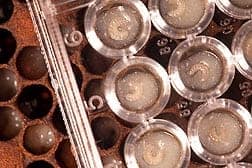U.S. Department of Agriculture (USDA) scientists have identified a bacterium that appears to give honey bee larvae a better chance of surviving to become pupae.
Molecular biologist Vanessa Corby-Harris and microbial ecologist Kirk E. Anderson at the Carl Hayden Bee Research Center in Tucson, Arizona, have named the new species Parasaccharibacter apium. The bee research center is part of the Agricultural Research Service, USDA’s chief intramural scientific research agency.
Honey bees have been under nearly constant and growing pressures from a whole host of stressors—diseases, poor nutrition, sublethal effects of pesticides and many others, especially for the last 30 years. It has been known that a number of different bacteria live within adult bees and in the hive, and scientists have been studying if and how these bacteria help deal with some of these stresses.
This is the first bacteria found to offer a benefit to bee larvae. In laboratory experiments, bee larvae fed P. apium had about an average of 30 percent better survival compared to those fed a sterile control.
How P. apium confers this survival advantage to the larvae is not yet known, according to Corby-Harris.
So far, the researchers have found P. apium only in honey bees and their hives. While P. apium found in honey bee hives is a distinct and new species from any previously identified, it has very close, naturally occurring relatives found in the nectar of many flowers, including cactus flowers, daisies, thistles and apple blossoms.
The genome of P. apium has been sequenced and they are beginning to dissect the functional properties that distinguish flower-living Acetobacteraceaefrom those that have coevolved with the honey bee hive. Pinpointing these ecological differences will be key to understanding the function of P. apium in honey bee hives, Anderson explained.
With minimal sampling effort, P. apium was found in nearly every one of the healthy managed bee colonies examined by the researchers. A future study will explore the abundance of P. apium in weak or struggling managed bee colonies.
While the mechanism by which the bacteria benefit the larvae remains to be studied, the importance is clear enough that Corby-Harris and Anderson are already field testing its use along with a number of other bacteria that may benefit the pollination and honey-production industry as potential management tools.

